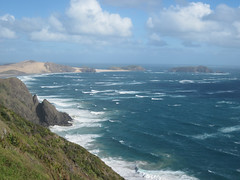I could easily become a Wellington groupie. Of all the cities we’ve visited for Kenton’s research—including Auckland, Christchurch, Dunedin—this self-styled capitol of New Zealand gets my five-star award.
It’s a funky, friendly place, with a feisty cafe culture and lively arts scene, reminiscent of 1970s-era San Francisco—before the coming of glitz and glitter, chrome and glass. The city’s business, arts and government districts fringe the bustling waterfront, which on a clear day has views across the harbor to the shores of the South Island.
More than a dozen suburbs spread out and squeeze into surrounding hills, snugged into neighborhood mazes of twisting roads that have barely enough room for a single car. Driving the hilly, hairpin curves felt like we were skimming the insides of nautilus shell.
But, we came to enjoy this precarious sport during our three-day stay at the home of Barry Rigby and Doris Janiewski, who taught history at UI in the 1980s. Their home tucks topside into one of Wellington’s many hills near Victoria University. As staff historian, Barry investigates Maori treaty claims with the Waitangi Tribunal; Doris teaches history at Victoria University.
While Kenton did his “newspapering,” I soaked up the arts—unbridled joy—beginning with Te Papa Museum, which we first visited in March. The two top floors are dedicated to the arts, with the lower three floors focusing on NZ’s diverse cultural history, natural heritage and special touring exhibits.
The City of Wellington Art Gallery was a major artistic highlight featuring the world-touring sound sculpture by Canadian artist Janet Cardiff entitled Forty-Part Motet. Forty speakers encircled the white high-ceiling space. Each played back one of 40 separately-recorded vocal parts of the Salisbury Cathedral Choir performing the Thomas Tallis polyphonic work “Spem in Alium Nunquam Habui” (1573).
Walking through the space, I didn’t hear the music as much as felt it, as though immersed in ethereal swirls of pure emotion and pure spirit. It was beyond words, really. I struggled to keep my eyes dry, finally bursting into tears, then furtively looking around me. I saw other people sprawled throughout the gallery wiping their eyes, too.
Public art is a big, very big, deal here. The Wellington Sculpture Trust prides itself on providing for “a measure of civic and artistic maturity” by commissioning works that are scattered throughout the city. Everywhere—from waterfront esplanades to retail alleyways to everywhere in between. Grandiose, elegant, fun, goofy—all exceptional.
I’ve never been as crazy about history museums as Kenton is, but I was taken by surprise at the Wellington Museum of City and Sea. The eclectic 10 Years in Wonderland juxtaposed—with playful exuberance and artistic flair—what might otherwise be seen as stuffy artifacts from the museum’s collections.
Like the setting for a fancy high tea, featuring a chair used to seat a chimpanzee for famous tea parties at the Wellington Zoo in the 1930s. Like the enclosed bubble of simulated ocean, showing off the workings of an antique, still functional, diving bell.
Funny … it’s got me thinking about possibilities for turning my collection of stuff (that I cannot seem to let go of) into a rotating household exhibit of things strange and weirdly wonderful. I could sell tickets, serve espresso, or champagne, have a party.
Why the heck not?!









